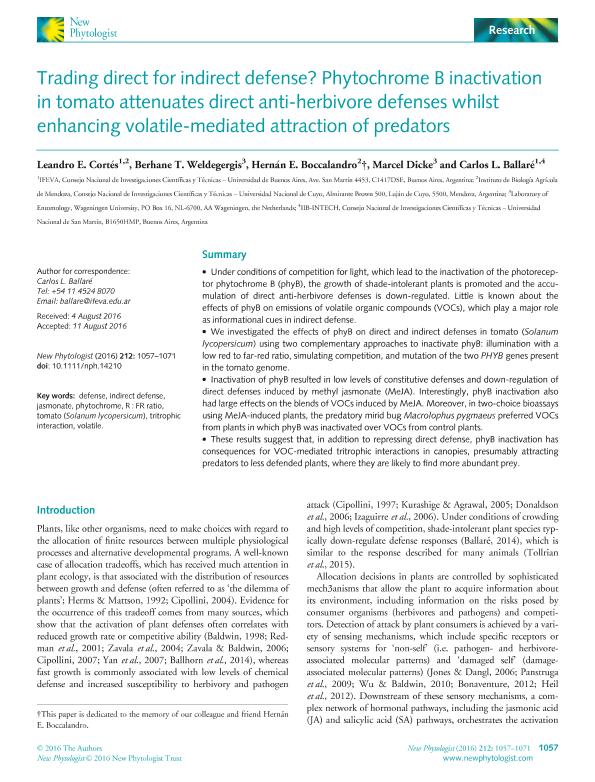Mostrar el registro sencillo del ítem
dc.contributor.author
Cortés, Leandro Emanuel

dc.contributor.author
Weldegergis, Berhane T.
dc.contributor.author
Boccalandro, Hernan Esteban

dc.contributor.author
Dicke, Marcel
dc.contributor.author
Ballare, Carlos Luis

dc.date.available
2018-06-21T20:14:49Z
dc.date.issued
2016-12
dc.identifier.citation
Cortés, Leandro Emanuel; Weldegergis, Berhane T.; Boccalandro, Hernan Esteban; Dicke, Marcel; Ballare, Carlos Luis; Trading direct for indirect defense? Phytochrome B inactivation in tomato attenuates direct anti-herbivore defenses whilst enhancing volatile-mediated attraction of predators; Wiley Blackwell Publishing, Inc; New Phytologist; 212; 4; 12-2016; 1057-1071
dc.identifier.issn
0028-646X
dc.identifier.uri
http://hdl.handle.net/11336/49595
dc.description.abstract
Under conditions of competition for light, which lead to the inactivation of the photoreceptor phytochrome B (phyB), the growth of shade-intolerant plants is promoted and the accumulation of direct anti-herbivore defenses is down-regulated. Little is known about the effects of phyB on emissions of volatile organic compounds (VOCs), which play a major role as informational cues in indirect defense. We investigated the effects of phyB on direct and indirect defenses in tomato (Solanum lycopersicum) using two complementary approaches to inactivate phyB: illumination with a low red to far-red ratio, simulating competition, and mutation of the two PHYB genes present in the tomato genome. Inactivation of phyB resulted in low levels of constitutive defenses and down-regulation of direct defenses induced by methyl jasmonate (MeJA). Interestingly, phyB inactivation also had large effects on the blends of VOCs induced by MeJA. Moreover, in two-choice bioassays using MeJA-induced plants, the predatory mirid bug Macrolophus pygmaeus preferred VOCs from plants in which phyB was inactivated over VOCs from control plants. These results suggest that, in addition to repressing direct defense, phyB inactivation has consequences for VOC-mediated tritrophic interactions in canopies, presumably attracting predators to less defended plants, where they are likely to find more abundant prey.
dc.format
application/pdf
dc.language.iso
eng
dc.publisher
Wiley Blackwell Publishing, Inc

dc.rights
info:eu-repo/semantics/openAccess
dc.rights.uri
https://creativecommons.org/licenses/by-nc-sa/2.5/ar/
dc.subject
Defense
dc.subject
Indirect Defense
dc.subject
Jasmonate
dc.subject
Phytochrome
dc.subject
R : Fr Ratio
dc.subject
Tomato (Solanum Lycopersicum)
dc.subject
Tritrophic Interaction
dc.subject
Volatile
dc.subject.classification
Otras Ciencias Biológicas

dc.subject.classification
Ciencias Biológicas

dc.subject.classification
CIENCIAS NATURALES Y EXACTAS

dc.title
Trading direct for indirect defense? Phytochrome B inactivation in tomato attenuates direct anti-herbivore defenses whilst enhancing volatile-mediated attraction of predators
dc.type
info:eu-repo/semantics/article
dc.type
info:ar-repo/semantics/artículo
dc.type
info:eu-repo/semantics/publishedVersion
dc.date.updated
2018-06-19T15:52:12Z
dc.identifier.eissn
1469-8137
dc.journal.volume
212
dc.journal.number
4
dc.journal.pagination
1057-1071
dc.journal.pais
Reino Unido

dc.journal.ciudad
Londres
dc.description.fil
Fil: Cortés, Leandro Emanuel. Consejo Nacional de Investigaciones Científicas y Técnicas. Centro Científico Tecnológico Conicet - Mendoza. Instituto de Biología Agrícola de Mendoza. Universidad Nacional de Cuyo. Facultad de Ciencias Agrarias. Instituto de Biología Agrícola de Mendoza; Argentina. Consejo Nacional de Investigaciones Científicas y Técnicas. Oficina de Coordinación Administrativa Parque Centenario. Instituto de Investigaciones Fisiológicas y Ecológicas Vinculadas a la Agricultura. Universidad de Buenos Aires. Facultad de Agronomía. Instituto de Investigaciones Fisiológicas y Ecológicas Vinculadas a la Agricultura; Argentina
dc.description.fil
Fil: Weldegergis, Berhane T.. Wageningen University; Países Bajos
dc.description.fil
Fil: Boccalandro, Hernan Esteban. Consejo Nacional de Investigaciones Científicas y Técnicas. Centro Científico Tecnológico Conicet - Mendoza. Instituto de Biología Agrícola de Mendoza. Universidad Nacional de Cuyo. Facultad de Ciencias Agrarias. Instituto de Biología Agrícola de Mendoza; Argentina
dc.description.fil
Fil: Dicke, Marcel. Wageningen University; Países Bajos
dc.description.fil
Fil: Ballare, Carlos Luis. Consejo Nacional de Investigaciones Científicas y Técnicas. Oficina de Coordinación Administrativa Parque Centenario. Instituto de Investigaciones Fisiológicas y Ecológicas Vinculadas a la Agricultura. Universidad de Buenos Aires. Facultad de Agronomía. Instituto de Investigaciones Fisiológicas y Ecológicas Vinculadas a la Agricultura; Argentina. Consejo Nacional de Investigaciones Científicas y Técnicas. Centro Científico Tecnológico Conicet - La Plata. Instituto de Investigaciones Biotecnológicas. Instituto de Investigaciones Biotecnológicas ; Argentina
dc.journal.title
New Phytologist

dc.relation.alternativeid
info:eu-repo/semantics/altIdentifier/doi/http://dx.doi.org/10.1111/nph.14210
dc.relation.alternativeid
info:eu-repo/semantics/altIdentifier/url/https://nph.onlinelibrary.wiley.com/doi/abs/10.1111/nph.14210
Archivos asociados
